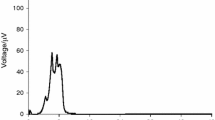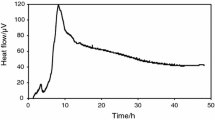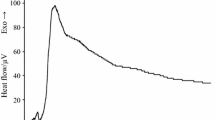Abstract
Microcalorimetry is a highly sensitive experimental technique that allows to determine the energy released by any process or transformation. In the field of medicine, it is interesting for investigations of microbial processes. The interaction relationship between Enterococcus faecalis and Pseudomonas aeruginosa was researched using a Tian–Calvet calorimeter equipped with two stainless steel cells (reference and experimental). Three samples from both bacteria were prepared in the following proportions: 20 + 80 % (0.2 mL E. faecalis + 0.8 mL P. aeruginosa), 50 + 50 % (0.5 mL E. faecalis + 0.5 mL P. aeruginosa) and 80 + 20 % (0.8 mL E. faecalis + 0.2 mL P. aeruginosa). Experiments were carried out at a concentration of 103 CFU mL−1 and a constant temperature of 309.65 K. Recording the heat voltage difference versus time, the growth curves for E. faecalis, P. aeruginosa and their mixtures were obtained. The differences in shape of curves of single microorganisms and their mixtures were compared. Also, the thermokinetic parameters of single microorganisms and their mixtures (growth constant, generation time, detection time and amount of heat released) were calculated.




Similar content being viewed by others
References
Braissant O, Wirz D, Göpfert B, Daniels AU. Use of isothermal microcalorimetry to monitor microbial activities. FEMS Microbiol Lett. 2010;303:1–8.
Calvet E, Prat H. Récents Progrès in Microcalorimétrie. Paris: Éditorial Dunod; 1958.
Lago N, Legido JL, Paz-Andrade MI, Arias I, Casás LM. Microcalorimetric study of the growth and metabolism of Pseudomonas aeruginosa. J Therm Anal Calorim. 2011;105:651–5.
Braissant O, Wirz D, Göpfert B, Daniels AU. Biomedical use of isothermal microcalorimeters. Sensors. 2010;10:9369–83.
James AM, editor. Calorimetry past, present and future. In: Thermal and energetic studies of cellular biological systems. Bristol: Wright; 1987. pp. 1–13.
Zaharia DC, Iancu C, Steriade AT, Muntean AA, Balint O, Popa VT, et al. MicroDSC study of Staphylococcus epidermidis growth. BMC Microbiol. 2010;10:322.
Rodriguez D, Daniels AU, Urrusti JL, Wirz D, Braissant O. Evaluation of a low-cost calorimetric approach for rapid detection of tuberculosis and other mycobacteria in culture. J Appl Microbiol. 2011;111(4):1016–24.
Rivero NL, Legido JL, Santos IA, Casás LM. Comparative study of microcalorimetric behavior of Escherichia coli, Proteus mirabilis and Klebsiella pneumoniae. Pol J Microbiol. 2012;61(3):199–204.
Bonkat G, Braissant O, Malte R, Solokhina A, Widmer AF, Frei R, et al. Standardization of isothermal microcalorimetry in urinary tract infection detection by using artificial urine. World J Urol. 2013;31(3):553–7.
O´Neill MAA, Vine GJ, Beezer AE, Bishop AH, Hadgraft J, Labetoulle C, et al. Antimicrobial properties of silver-containing wound dressings: a microcalorimetric study. Int J Pharm. 2003;263(1–2):61–8.
Trampuz A, Salzmann S, Antheaume J, Daniels AU. Microcalorimetry: a novel method for detection of microbial contamination in platelet products. Transfusion. 2007;47:1643–50.
Tan MR, Ren YS, Yan D, Meng XH, Cheng LH, Qiu LL, et al. Detection of microorganisms in different growth states based on microcalorimetry. J Therm Anal Calorim. 2012;109(2):1069–75.
Wang J, Cheng D, Zeng N, Xia H, Fu Y, Yan D, et al. Microcalorimetric study of the effect of Benzoinum and Styrax on the growth of Escherichia coli. Nat Prod Res. 2011;25(4):457–63.
Li XF, Jin C, He J, Zhou J, Wang HT, Dai B, et al. Microcalorimetric investigation of the antibacterial activity of curcumin on Staphylococccus aureus coupled with multivariate analysis. J Therm Anal Calorim. 2012;109(1):395–402.
Luo JY, Yang MH. Demethoxycurcumin: a potential antimicrobial agent. J Therm Anal Calorim. 2014;115(3):2331–8.
Baldoni D, Steinhuber A, Zimmerli W, Trampuz A. In vitro activity of gallium maltolate against Staphyloccocci in logarithmic, stationary, and biofilm growth phases: comparison of conventional and calorimetric susceptibility testing methods. Antimicrob Agents Chemother. 2010;54:157–63.
von Ah U, Wirz D, Daniels AU. Isothermal micro calorimetry—a new method for MIC determinations: results for 12 antibiotics and reference strains of E. coli and S. aureus. BMC Microbiol. 2009;. doi:10.1186/1471-2180-9-106.
Yang LN, Sun LX, Xu F, Zhang J, Zhao JN, Zhao ZB, et al. Inhibitory study of two cephalosporins on E. coli by microcalorimetry. J Therm Anal Calorim. 2010;100(2):589–92.
Entenza JM, Bétrisey B, Manuel O, Giddey M, Sakwinska O, Laurent F, et al. Rapid detection of Staphylococcus aureus strains with reduced susceptibility to vancomycin by isothermal microcalorimetry. J Clin Microbiol. 2014;52(1):180–6.
Braissant O, Chavanne P, de Wild M, Pieles U, Stevanovic S, Schumacher R, et al. Novel microcalorimetric assay for antibacterial activity of implant coatings: the cases of silver-doped hydroxyapatite and calcium hydroxide. J Biomed Mater Res B Appl Biomater. 2014;. doi:10.1002/jbm.b.33294.
Rivero NL, Soto JLL, Santos IA, Casás LM. Differentiation between Staphylococcus aureus and Staphylococcus epidermidis using microcalorimetry. Int J Thermophys. 2013;34:1039–48.
von Ah U, Wirz D, Daniels AU. Rapid differentiation of methicillin-susceptible Staphylococcus aureus from methicillin-resistant S. aureus and MIC determinations by isothermal microcalorimetry. J Clin Microbiol. 2008;46(6):2083–7.
Baldoni D, Hermann H, Frei R, Trampuz A, Steinhuber A. Perfomance of microcalorimetry for early detection of methicillin resistance in clinical isolates of Staphylococcus aureus. J Clin Microbiol. 2009;47(3):774–6.
Vázquez C, Lago N, Legido JL, Arias I, Casás LM, Mato MM. Microcalorimetric study of the growth of Enterococcus faecalis, Klebsiella pneumoniae and their mixtures in an enriched culture medium. J Therm Anal Calorim. 2013;. doi:10.1007/s10973-013-3287-9.
Vázquez C, Lago N, Mato MM, Casás LM, Esarte L, Legido JL, Arias I. Microcalorimetric perfomance of the growth in culture of Escherichia coli, Proteus mirabilis and their mixtures in different proportions. J Therm Anal Calorim. 2014;. doi:10.1007/s10973-013-3535-z.
Engleberg NC, DiRita V, Dermody TS. Schaechter’s mechanisms of microbial disease. 5th ed. Philadelphia: Lippincott Williams & Wilkins; 2013.
Paz Andrade MI. Les Developements Recents de la Microcalorimetrie et de la Thermogenese. 1st ed. Paris: CRNS; 1967.
Verdes PV, Mato MM, Paz Andrade MI, Legido JL. Contribution to study of the thermodynamics properties of mixtures containing 2-methoxy-2-methylpropane, alkanol, alkane. J Chem Therm. 2014;73:224–31.
Lago N, Legido JL, Casás LM, Arias I. Microcalorimetric study of the growth of Enterococcus faecalis in an enriched culture medium. J Therm Anal Calorim. 2012;108:665–70.
Astasov-Frauenhoffer M, Braissant O, Hauser-Gerspach I, Daniels AU, Weiger R, Waltimo T. Isothermal microcalorimetry provides new insights into biofilm variability and dynamics. FEMS Microbiol Lett. 2012;337(1):31–7.
Said J, Walker M, Parsons D, Stapleton P, Beezer AE, Gaisford S. Development of a flow system for studying biofilm formation on medical devices with microcalorimetry. Methods. 2014;. doi:10.1016/j.ymeth.2014.12.002.
Ma J, Qi WT, Yang LN, Yu WT, Xie YB, Wang W, et al. Microcalorimetric study on the growth and metabolism of microencapsulated microbial cell culture. J Microbiol Methods. 2007;68:172–7.
Braissant O, Bonkat G, Wirz D, Bachmann A. Microbial growth and isothermal microcalorimetry: growth models and their application to microcalorimetric data. Thermochim Acta. 2013;555:64–71.
Acknowledgements
We thank María Perfecta Salgado Gonzalez and Sofia Baz Rodríguez for their collaboration with the technical measures. We are also thankful for the financial support provided by the Projects EM 2012/141, CN 2012/285, and “Agrupación Estratégica de Biomedicina (INBIOMED)” by “Xunta de Galicia” and the Project FIS 2011-23322 funded by Ministry of Science and Innovation of Spain. All these projects are co-financed with FEDER funds.
Author information
Authors and Affiliations
Corresponding author
Rights and permissions
About this article
Cite this article
Vazquez, C., Lago, N., Mato, M.M. et al. Microcalorimetric study of the growth of Enterococcus faecalis, Pseudomonas aeruginosa and their mixtures in an enriched culture medium. J Therm Anal Calorim 121, 463–468 (2015). https://doi.org/10.1007/s10973-015-4606-0
Received:
Accepted:
Published:
Issue Date:
DOI: https://doi.org/10.1007/s10973-015-4606-0




